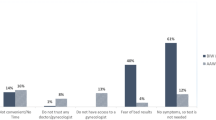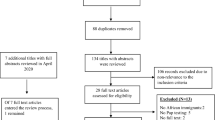Abstract
Although the incidence of cervical cancer has been declining steadily since the Pap smear became standard of care in the U.S., many African immigrants are unfamiliar with this screening test and its potential benefits. Using data from the CDC’s National Health Interview Surveys, we identified respondents who were black women living in the United States, distinguishing U.S.-born (n = 620) and African-born (n = 36). We constructed a measure of current Pap status and used multivariate logistic regression models to compare Pap status between the two groups. Controlling for income, age, education, health insurance, and marital status, African American women were over 3 times more likely to have reported a current Pap smear than African-born women [Adjusted OR = 3.37, 95 % CI = (1.89, 5.96)]. Being an African-born woman was the strongest predictor of current Pap status. Distinguishing immigrant status in an analysis of cervical cancer screening rates for black women indicated much lower Pap smear rates for African-born women, compared with African-American women. More research on the impact of education and culturally specific care is needed to address the disparity in Pap smear rates for African-born black women.
Similar content being viewed by others
References
Siegel J, Horan SA, Teferra T. Health and health care status of African-Born residents of metropolitan Washington, DC. J Immigr Health. 2001;3(4):213–24.
Abdykkagu A, Copping J, Kessel A, et al. Cervical screening: perceptions and barriers to uptake among Somali women in Camden. Public Health. 2009;123:680–5.
Samuel P, Pringle J, James N IV, et al. Breast, cervical and colorectal screening rates amongst female Cambodian, Somalian and Vietnamese immigrants in the US. Int J Equity Health. 2009;8:30.
Soerjomataram I, Lortet-Tieulent J, Parkin DM, et al. Global burden of cancer in 2008: a systematic analysis of disability-adjusted life-years in 12 world regions. Lancet. 2012;380:1840–50.
American Cancer Society. Cancer in Africa. Atlanta: American Cancer Society; 2011.
Oh J, Weiderpass E. Infection and cancer: global distribution and burden of diseases. Ann Glob Health. 2014;80(5):384–92.
Watson-Jones D, Baisley K, Brown J, et al. High prevalence and incidence of human papillomavirus in a cohort of healthy young African female subjects. Sex Transm Infect. 2013;89:358–65.
Sangwa-Lugoma G, Ramanakumar AV, Mahmud S, et al. Prevalence and determinants of high-risk human papillomavirus infection in women from a Sub-Saharan African community. Sex Transm Dis. 2011;38:308–15.
Ford N, Narayan K, Mehta N. Diabetes among US- and foreign-born blacks in the USA. Ethn Health. 2015;19:1–14.
Odedina F, Dagne G, LaRose-Pierre M, et al. Within-group differences between native-born and foreign-born Black men on prostate cancer risk reduction and early detection practices. J Immigr Minor Health. 2011;13(6):996–1004.
Morrison T, Wieland M, Cha S, et al. Disparities in preventive health services among Somali immigrants and refugees. J Immigr Minor Health. 2012;14(6):968–74.
Minnesota Department of Human Services: Disparities and Barriers to Utilization among Minnesota Health Care Program Enrollees, Final Report, June 2009.
HRSA 2012 Health Center profile: http://bphc.hrsa.gov/uds/datacenter.aspx?q=d&bid=0516700&state=MN.
Cook N, Kobetz E, Reis I, et al. Role of patient race/ethnicity, insurance and age on pap smear compliance across ten community health centers in Florida. Ethn Dis. 2010;20:321–6.
Benard V, Lee NC, Piper M, Richardson L. Race-specific rate of Papanicolaou testing and the rate of cervical neoplasia in the National Breast and Cervical Cancer Early detection program 1991–1998 (United States). Cancer Causes Control. 2001;12:61–8.
Sirovich BE, Welch HG. The frequency of pap smear screening in the United States. J Gen Intern Med. 2004;19:243–50.
SEER Cancer Statistics.1973–2011. Bethesda, MD: National Cancer Institute: http://seer.cancer.gov/statfacts/html/cervix.html.
Venters H, Gany F. African immigrant health. J Immigr Minority Health. 2011;13:333–44.
United States. Census Bureau. Population Division. “Table FBP-1. Profile of Selected Demographic and Social Characteristics: 2000.” United States Census 2000. Washington: US Census Bureau, 4 Mar. 2004. Web. 12 Aug. 2009. <http://www.census.gov/population/foreign/files/stp-159/STP-159-africa.pdf>.
Minnesota Population Center and State Health Access Data Assistance Center, Integrated Health Interview Series: Version 5.0. Minneapolis: University of Minnesota, 2012. http://www.ihis.us.
National Center for Health Statistics. Data file documentation, National Health Interview Survey, 2008 (machine readable data file and documentation). Hyattsville: National Center for Health Statistics, Centers for Disease Control and Prevention; 2009.
National Center for Health Statistics. Data file documentation, National Health Interview Survey, 2010 (machine readable data file and documentation). Hyattsville: National Center for Health Statistics, Centers for Disease Control and Prevention; 2011.
Selvin E, Brett K. Breast and cervical cancer screening: sociodemographic predictors among White, Black, and Hispanic women. Am J Public Health. 2003;93(4):618–23.
Minnesota Department of Health: Advancing Health Equity in Minnesota: Report to the Legislature. February 1, 2014.
National Cancer Institute at the National Institutes of Health. Cervical Cancer Screening (PDQ®). http://www.cancer.gov/cancertopics/pdq/screening/cervical/HealthProfessional.
Carroll J, Epstein R, Fiscella K, et al. Knowledge and beliefs about health promotion and preventive health care among Somali women in the United States. Health Care Women Int. 2007;28(4):360–80.
Piwowarczyk L, Bishop H, Saia K, et al. Pilot evaluation of a health promotion program for African immigrant and refugee women: the UMJAMBO program. J Immigr Minor Health. 2013;15:219–23.
Murray K, et al. Health and prevention among East African women in the U.S. J Health Care Poor Underserved. 2013;24(1):233–46.
Acknowledgments
A. Forney-Gorman would like to thank Ann D. Smith, M.D. for the helpful edits and comments on the article. The interviews performed for this project with Obsa Hassan, M.D., Fartun Weli, MPH and Rahel Ghebre, M.D. provided important insight for this research.
Author information
Authors and Affiliations
Corresponding author
Ethics declarations
Human Participant Protection
Data for this study included public use files from the Integrated Health Interview Series (IHIS). Research using IHIS files is exempt from IRB review as these are existing records that are de-identified and publicly available.
Rights and permissions
About this article
Cite this article
Forney-Gorman, A., Kozhimannil, K.B. Differences in Cervical Cancer Screening Between African-American Versus African-Born Black Women in the United States. J Immigrant Minority Health 18, 1371–1377 (2016). https://doi.org/10.1007/s10903-015-0267-0
Published:
Issue Date:
DOI: https://doi.org/10.1007/s10903-015-0267-0




